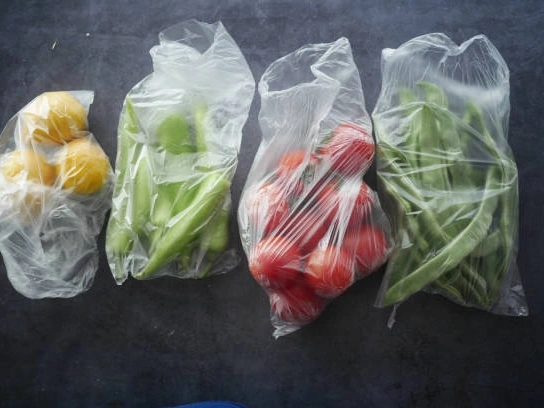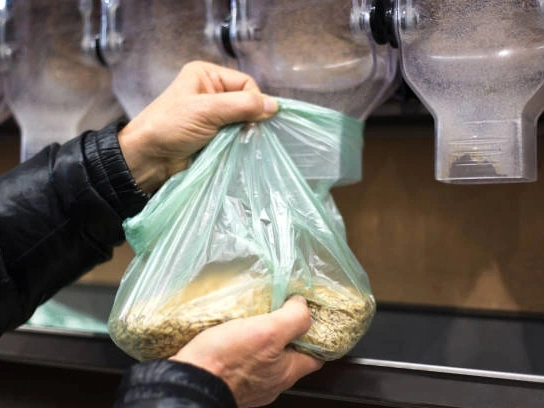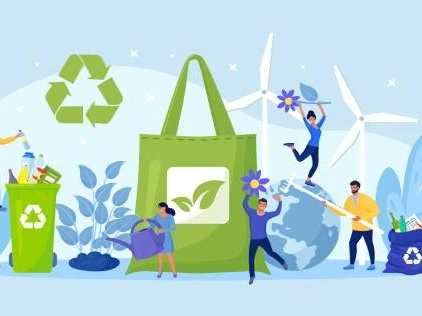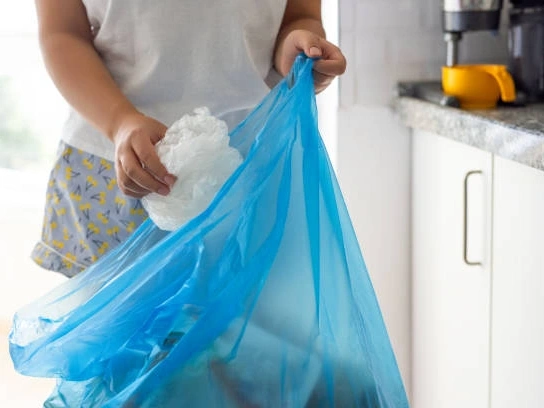Plastic bags are an integral part of our daily lives and commercial activities. From grocery shopping to packaging various products, they are everywhere. However, the widespread use of traditional plastic bags has led to severe environmental problems. These non – biodegradable bags can persist in the environment for hundreds of years, polluting landfills, oceans, and other natural habitats.
With the increasing awareness of environmental protection, biodegradable and compostable plastic bags have emerged as promising alternatives. As consumers, we often wonder which one is better for our needs and the environment. This blog post aims to explore the differences between these two types of eco – friendly plastic bags, helping you make an informed choice.
Biodegradable Plastic Bags

Definition and Materials
Biodegradable plastic bags are designed to be broken down by microorganisms in the natural environment. The scientific definition implies that these bags can be decomposed into small – molecule substances such as carbon dioxide, water, and biomass through the action of bacteria, fungi, and other microbes.
Common materials used in biodegradable plastic bags include polylactic acid (PLA) and polyhydroxyalkanoate (PHA). PLA is derived from renewable resources like corn, sugarcane, and cassava. These raw materials are fermented to produce lactic acid, which is then polymerized to form PLA. PLA has good mechanical properties and is widely used in various applications. PHA, on the other hand, is synthesized by microorganisms under specific conditions. It has excellent biocompatibility and biodegradability, making it a great choice for environmentally friendly products.
Degradation Conditions
The degradation of biodegradable plastic bags is highly influenced by several factors. Temperature plays a crucial role. Generally, higher temperatures can accelerate the degradation process. For instance, in tropical regions with an average temperature above 30°C, biodegradable bags may start to show significant signs of degradation within a few months. In contrast, in cold regions with temperatures below 10°C, the degradation can be extremely slow, taking years to complete.
Humidity is another important factor. Adequate moisture is necessary for the growth and activity of microorganisms. In a humid environment, such as a damp forest floor or a wetland, the degradation rate of biodegradable bags is much faster compared to a dry desert area. The types of microorganisms also matter. Different microbes have different enzyme systems, which can break down specific materials. In a landfill with a diverse microbial community, biodegradable bags made of PHA may degrade more rapidly due to the presence of specialized microbes that can utilize PHA as a carbon source.
Advantages
One of the most significant advantages of biodegradable plastic bags is their ability to reduce plastic pollution. Unlike traditional plastic bags that accumulate in the environment, biodegradable bags can break down over time, alleviating the pressure on landfills and reducing the amount of plastic waste in our oceans and waterways.
They are also highly versatile. Whether you are going grocery shopping, packing a lunch, or wrapping a small gift, biodegradable plastic bags can serve your purpose. Their wide range of applications makes them a convenient choice for consumers who want to make an eco – friendly switch without sacrificing functionality.
Disadvantages
The degradation time of biodegradable plastic bags is highly variable and can be a major drawback. Depending on the environmental conditions, it can take anywhere from a few months to several years for these bags to fully decompose. In some cases, if the environment is not conducive to degradation, such as in a cold, dry landfill, the bags may persist for a long time, not achieving the expected environmental benefits.
Moreover, some biodegradable plastic bags contain additives to improve their performance, such as enhancing their strength or flexibility. However, these additives may be non-biodegradable or may release harmful substances during the degradation process. For example, certain additives can break down into microplastics, which are extremely small plastic particles that can enter the food chain and have negative impacts on wildlife and human health.
Compostable Plastic Bags

Definition and Materials
Compostable plastic bags are designed to be transformed into nutrient-rich compost under specific conditions. To be considered compostable, a bag must meet certain standards, such as being able to decompose completely within a reasonable time frame and leaving no harmful residues.
Common materials for compostable plastic bags include starch-based materials, cellulose, and polybutylene adipate terephthalate (PBAT). Starch-based materials, like corn starch or potato starch, are derived from plants. They are biodegradable and can be easily broken down by microorganisms. Cellulose, the main component of plant cell walls, is also a popular choice. It is abundant in nature and has good biodegradability. PBAT is a biodegradable polymer that is often blended with other materials to improve the performance of compostable bags.
Composting Conditions
Industrial composting of compostable plastic bags requires strict conditions. The temperature needs to be maintained between 55 – 70°C. This high-temperature environment accelerates the decomposition process by promoting the growth and activity of thermophilic microorganisms. Humidity should be kept at 50%-60 % to provide a suitable environment for the microbes. Good ventilation is also essential to supply oxygen, which is necessary for aerobic decomposition. Under these optimal conditions, industrial composting facilities can break down compostable plastic bags within 90 – 180 days.
Home composting, on the other hand, has its limitations. The temperature in a home compost pile is usually much lower, typically ranging from 20 – 30°C. It is also difficult to control the humidity and ventilation accurately. As a result, few compostable plastic bags are suitable for home composting, and the degradation process may be incomplete or much slower.
Advantages
Compostable plastic bags excel in the recycling of organic waste. When used to contain organic materials like food scraps or yard waste, these bags can be composted together, turning waste into valuable compost. This not only reduces the amount of waste sent to landfills but also closes the loop on the organic waste cycle, promoting a more sustainable lifestyle.
The compost produced from compostable plastic bags is rich in nutrients and can significantly improve soil structure and fertility. When applied to agricultural fields or gardens, it can enhance plant growth, reduce the need for synthetic fertilizers, and contribute to the overall health of the ecosystem.
Disadvantages
One of the major drawbacks of compostable plastic bags is their heavy reliance on professional composting facilities. In many areas, especially in small towns and rural regions, such facilities are either nonexistent or limited. Without access to proper industrial composting, compostable plastic bags may end up in landfills, where they cannot degrade effectively due to the lack of the required conditions.
The market for compostable plastic bags is also plagued by quality issues. There are many products on the market that falsely claim to be compostable. These falsely labeled products not only mislead consumers but also undermine the credibility of the entire compostable plastic bag industry. Consumers need to be vigilant and look for reliable certification marks to ensure they are purchasing genuine compostable products.
Biodegradable vs Compostable Plastic Bags

Degradation Process Comparison
| Comparison Items | Biodegradable Plastic Bags | Compostable Plastic Bags |
| Degradation Time | Months to years, depending on environmental conditions | 90 – 180 days in industrial composting |
| Degradation Products | Carbon dioxide, water, biomass, and potentially harmful additives or microplastics | Carbon dioxide, water, and nutrient – rich compost |
| Environmental Impact | May cause harm due to potential microplastics or harmful additives | Beneficial for soil improvement and waste recycling |
As shown in the table, the degradation time of biodegradable plastic bags is highly variable, while compostable plastic bags have a more predictable degradation time in industrial composting. The degradation products also differ significantly, with compostable bags producing nutrient-rich compost, while biodegradable bags may leave behind harmful substances.
Application Scenarios Comparison
In urban areas with well-developed waste management systems and accessible industrial composting facilities, compostable plastic bags are a great choice for packaging organic waste, such as in restaurants for food waste or in farmers’ markets for fresh produce. In contrast, in rural areas where industrial composting facilities are scarce, biodegradable plastic bags may be more practical for general use, as they can at least start to degrade in the natural environment over time.
For grocery shopping in big cities, if the store has a composting program, compostable bags can be used to carry fruits, vegetables, and other items. However, if the local waste management system does not support composting, biodegradable bags can be a better alternative to traditional plastic bags. In the case of rural agricultural packaging, biodegradable bags may be more suitable due to the lack of composting infrastructure.
Cost Comparison
The production cost of compostable plastic bags is generally 20% – 30% higher than that of biodegradable plastic bags. This is mainly because the materials used in compostable bags, such as high-quality starch-based materials and specialized polymers like PBAT, are more expensive. The complex production processes required to meet the strict composting standards also contribute to the higher cost.
In the consumer market, biodegradable plastic bags are often more affordable, making them more accessible to price-sensitive consumers. However, the price of biodegradable bags can also vary depending on the brand and the quality of the product. Compostable plastic bags, due to their higher production cost, are usually more expensive for consumers, which may deter some from choosing them despite their environmental benefits.
How to Choose Them?

Based on Personal Needs
If you live in an area with easy access to industrial composting facilities and generate a lot of organic waste, compostable plastic bags are the way to go. For example, if you are a restaurant owner or a gardener who regularly composts yard waste, these bags can simplify your waste management process.
On the other hand, if you live in a place where composting facilities are limited or non-existent, and you mainly use plastic bags for general shopping or packaging, biodegradable plastic bags can be a more practical choice. Consider your usage frequency as well. If you use plastic bags frequently, the cost may be a significant factor, and biodegradable bags, which are generally more affordable, may be a better fit for your budget.
Considering Environmental Factors
Choosing an environmentally friendly plastic bag is crucial for the well-being of our planet. By opting for biodegradable or compostable plastic bags, you can significantly reduce your plastic footprint. When making a purchase, always look for reliable certification marks. The BPI (Biodegradable Products Institute) certification ensures that a product meets the standards for compostability, while the OK Compost mark is another indication of a product’s suitability for composting. These certifications help you identify genuine eco-friendly products and avoid being misled by falsely labeled items.
Conclusion
In conclusion, both biodegradable and compostable plastic bags offer viable alternatives to traditional plastic bags. Biodegradable plastic bags are more versatile and have a wider range of applications, but they come with the drawback of variable degradation times and potential environmental hazards from additives. Compostable plastic bags, on the other hand, are excellent for recycling organic waste and improving soil quality, but they rely heavily on professional composting facilities and can be more expensive.
As consumers, it is our responsibility to understand the differences between these two types of bags and make choices that are both convenient for us and beneficial for the environment. By choosing the right eco-friendly plastic bag, we can contribute to the global effort to reduce plastic pollution and create a more sustainable future. So, the next time you reach for a plastic bag, take a moment to consider which type is the best fit for your needs and the planet.